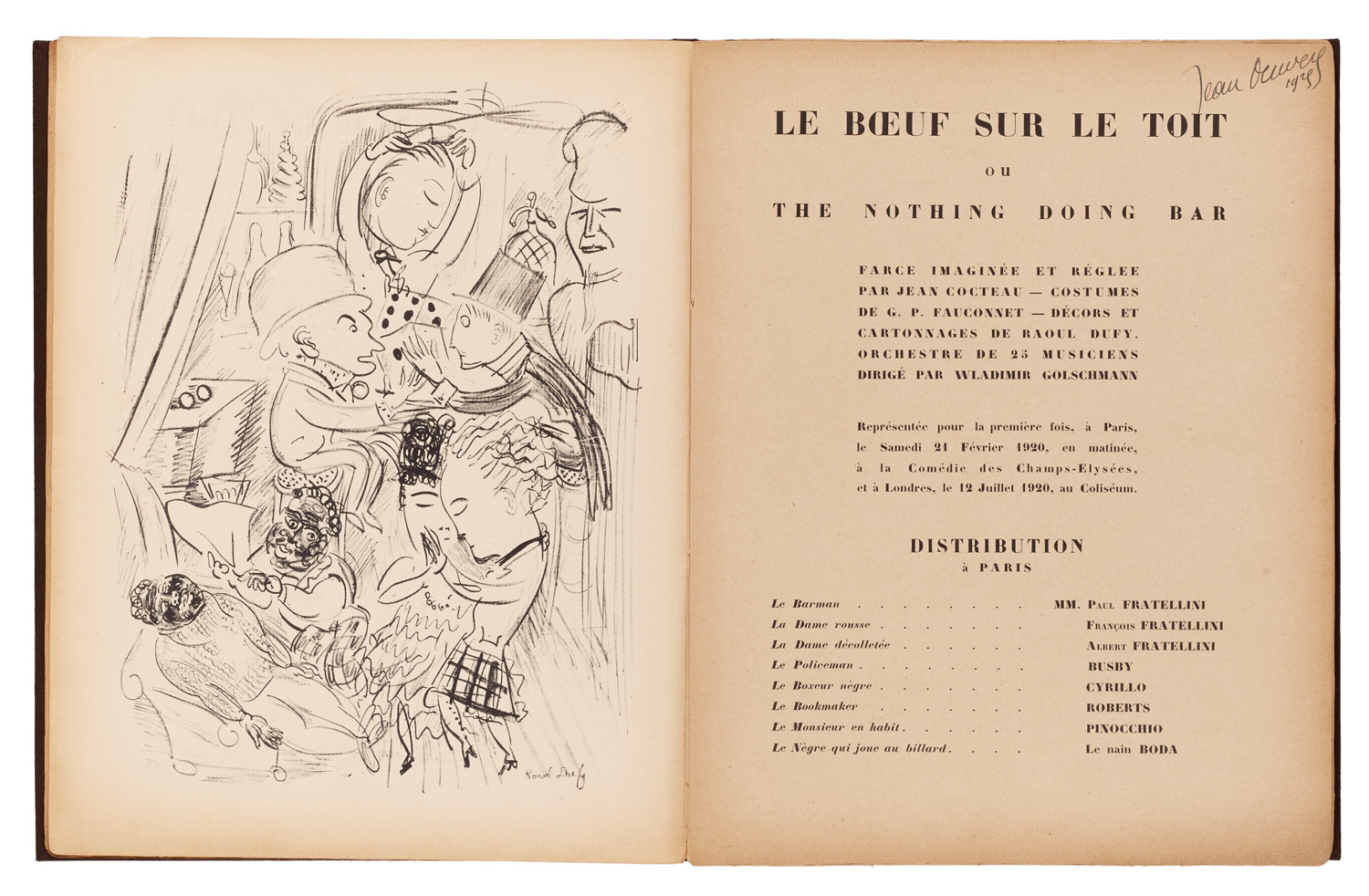
'FAIRE LE BOEUF'
MILHAUD, Darius.
Le boeuf sur le toit, ou The nothing doing bar. Farce imaginée et réglée par Jean Cocteau – costumes de G. P. Fauconnet – décors et cartonnages de Raoul Dufy. Orchestre de 25 musiciens dirigé par Wladimir Golschmann. Représentée pour la première fois, à Paris, le samedi 21 Février 1920, en matinée, à la Comédie des Champs-Elysées, et à Londres, le 12 Juillet 1920, au Coliséum.
Paris, Editions de la Sirène, 1920.
Folio, pp. [viii], 56, with full-page lithographed frontispiece illustration by Raoul Dufy; plate no. E.D. 24 L.S.; paper very lightly browned, one or two small marginal repairs, but a very good copy in the original printed grey wrappers; edges slightly discoloured, a few losses along spine; preserved in a cloth folder with slipcase; price stamp of Paris music-seller on end leaf, contemporary ownership inscription on upper cover and on title-page.

Added to your basket:
Le boeuf sur le toit, ou The nothing doing bar. Farce imaginée et réglée par Jean Cocteau – costumes de G. P. Fauconnet – décors et cartonnages de Raoul Dufy. Orchestre de 25 musiciens dirigé par Wladimir Golschmann. Représentée pour la première fois, à Paris, le samedi 21 Février 1920, en matinée, à la Comédie des Champs-Elysées, et à Londres, le 12 Juillet 1920, au Coliséum.
First edition of Milhaud’s Le boeuf sur le toit, Op. 58 (The ox on the roof, or The nothing-doing bar), a surrealist ballet-farce which became extremely popular in 1920s Paris.
The scenario is provided by Jean Cocteau, and the work is arranged for two pianos by the composer. This is one of Milhaud’s most frequently performed and recorded orchestral works. Milhaud had originally intended the piece to accompany a silent Charlie Chaplin film, but he was persuaded by Cocteau to let it be staged as a pantomime for acrobats and clowns. The first actors were clowns from the Medrano circus, the Fratellini. Raoul Dufy provided the stage designs, and the costumes and large masks were by Guy-Pierre Fauconnet.
The première was given in February 1920 at the Théâtre des Champs-Élysées with an orchestra of twenty-five, in a programme which also included Trois petites pièces montées, written by Erik Satie for the show, the ballet Adieu New York by Georges Auric, and Francis Poulenc’s Cocardes. The action was performed in slow motion like a dream sequence, while the music rushed full speed ahead. The stage set is that of a bar frequented by a number of characters: a boxer, a dwarf, a lady of fashion, a red-headed woman dressed as a man, a bookmaker, a gentleman in evening dress, a policeman who is decapitated by the blades of an overhead fan before being revived, and a number of others. A London production ran for two weeks in July 1920, although The Times reported that ‘a Coliseum audience could make nothing of it’.
The title of the piece is taken from an old Brazilian tango, and the composition is strongly influenced by Brazilian music. The overall structure, however, is a rondeau-avec-reprises in the spirit of Couperin or Rameau. In 1921 Le boeuf sur le toit gave its name to a Parisian cabaret-bar, formerly La Gaya, which was a meeting place for Cocteau, Milhaud, and their circle: Milhaud could often be heard playing a six handed version of the piece on the piano there, with Georges Auric and Arthur Rubinstein. The new club became a very popular centre of Paris cabaret society; jazz musicians from other Paris clubs would gather there after hours and play long into the night, giving rise to the expression ‘faire le boeuf’ – still used today in French to describe a jam session.

